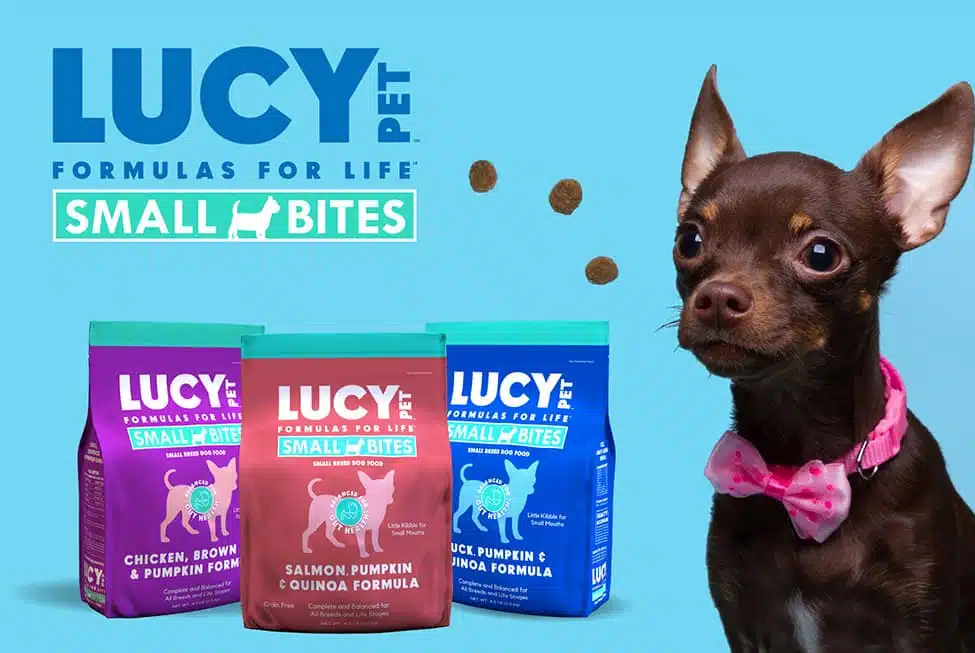
The Importance of Carbohydrates for Pets
In some circles, carbohydrates have gotten a bad reputation due to misinformation, or a simple lack of understanding. When we think of carbohydrates, our minds often jump to pasta, white bread and banana splits. We equate carbohydrates with fat and make the mistake of thinking to ourselves “I’m cutting all carbohydrates from my diet” when we shop for groceries. Some people mistakenly assume that all carbs are bad and then must be bad for our pets. This is an overly simplified view and completely inaccurate approach to healthy eating. Healthy eating is often about choosing the right types of foods (including carbohydrates) in the right quantities. If you consume too many calories, regardless of the source, it can lead to obesity and other health issues. In short, carbs are not bad.
The truth is we need carbohydrates in our diets, and so do our pets. Glucose is the metabolic fuel required by the brain, central nervous system and mammary gland. Carbohydrates in pet food play a pivotal role in the health of your pet and shouldn’t be minimized.
Read on to learn more about the importance of carbohydrates in your pet’s balanced diet!
Carbohydrates in Pet Food
There is a great deal of misleading information that can misrepresent the role and value of carbohydrates in nutrition. Here are a few quick facts about carbohydrates:
- Carbohydrates provide glucose, a compound required by the brain and central nervous system.
- Carbohydrates provide energy, which is essential to survive.
- Cats and dogs are very efficient at digesting and converting carbs into energy.
- It is much more difficult to obtain energy solely from meat/fish protein. It takes longer and is more taxing to the body, so a diet with zero carbs actually creates more physical challenges to metabolism and may even cause digestive issues. What is key, however, is the type of carbs used in a diet, and how they are blended with protein and fats.
- As a point of differentiation, there are “simple carbohydrates” and “complex carbohydrates” that digest differently and convert to energy differently.
A Brief Breakdown of Carbohydrates
Just like human beings, our pet’s bodies rely on three macronutrients for survival: protein, fat and—yep, you guessed it!—carbohydrates.
Carbohydrates provide energy for our brain and bodily functions. Depending on the type, carbohydrates come in four categories that your pet’s digestive system can process:
- Starches
- Sugars
- Oligosaccharides
- Fibers
Starches and Sugars Bring the Energy
Pets produce enzymes in their small intestine and pancreas that enable them to digest starches and sugars and break them down into glucose. In addition to helping our brain and nervous system function properly, glucose is a crucial energy source for humans and animals alike that fuels our bodily cells. Glucose is then absorbed by your pet from the intestine, enters the blood and is transported to the liver, where it is converted instantly into energy.
Oligosaccharides are prebiotic fibers that help promote the growth of probiotics, or healthy bacteria, which help your dog or cat extract gut health benefits from the food they consume.
Fiber is Good for the Gut
Unlike starches and sugars, fiber cannot be broken down and converted into readily available energy by the enzymes your pet produces in the digestive system. Fiber does, however, aid your pet’s digestive system in two crucial ways:
- Soluble Fibers – Found in most whole grains, soluble fibers feed the useful bacteria in your pet’s colon that produces short-chain fatty acids. These fatty acids help eliminate negative, disease-causing bacteria from your pet’s stomach. It also nurtures the cells in your pet’s colon, which keeps the digestive system healthy.
- Insoluble Fibers – Found in whole wheat as well as beans, cauliflower, nuts and potatoes, insoluble fibers which help aid laxation that ensures that the digestive tract functions properly and a high quality stool is excreted.
Whether soluble or insoluble, all fibers boost your pet’s metabolism and help it feel full after eating, which helps prevent obesity to maintain a healthy body weight.
Common Arguments Against Carbohydrates in Pet Food
Oftentimes, you’ll hear people argue that carbohydrates don’t bring anything to the table that protein can’t. Let’s take a closer look at those arguments and why that thinking is ill-conceived, with some myth-busting.
Myth: The “Carbohydrates Aren’t Essential to Make Glucose” Argument
One common argument against carbohydrates in pet food is that, unlike protein and fat, which pets wouldn’t be able to survive without, carbohydrates aren’t an essential macronutrient for animals. This is technically true. If absolutely necessary, their bodies could convert protein to glucose, but the body has to work much harder to accomplish this.
The process of breaking down amino acids, the building blocks of protein, to glucose requires your pet’s digestive system to expend energy breaking down protein into smaller protein chains called peptides, then to amino acids, then finally to glucose. All this energy being used on the “middlemen” gets taken away from building lean muscle tissue and support of other vital functions in your pet’s body.
So why make your pet’s body work harder to get energy from a protein and fat-only diet when it can get immediate energy from carbohydrates?
Myth: The “Wolves Don’t Raid Cornfields” Argument
Another common argument against carbohydrates is that “wolves don’t raid cornfields.” In other words, if wolves truly needed carbohydrates to survive in the wild, they would seek out crops as ravenously as they prey on other animals.
Let’s start with the obvious: wolves and dogs aren’t the same animals. Despite marketing hype from some companies, your dog is not a wolf. Yes, dogs descended from wolves, but dogs have evolved over 12,000 years to be quite different from their ancestors in several distinct ways:
- Genetic Makeup – The difference in DNA structure between dogs and wolves is 0.8%. That may seem like splitting hairs, but to put it into perspective, human DNA is 1.2% different from chimpanzees. One of the key distinctions that separate dogs from wolves is the presence of ten genes that promote dogs’ ability to digest starch efficiently
- There are 36 parts of the genome (DNA) that differ between dogs and wolves, 10 of which play a critical role in starch digestion and fat metabolism. (A genome is an organism’s complete set of DNA, including all of its genes).
- These genetic differences in the genome between dogs and wolves include the ability of dogs to digest carbohydrates and fat (for energy), which was a crucial step in the early domestication of dogs and enabled dogs to obtain energy efficiently from food.
- Omnivorous Teeth – Dogs have flatter premolars and molars than wolves, which are designed for digging into plant-based protein
- Ability to Produce Enzymes – Unlike wolves, dogs have the ability to produce amylase, a digestive enzyme that can break down starches and sugars to glucose
- Longer Intestines – Because meat is relatively easy to digest, wolves (like all carnivores) have short digestive tracts. Dogs’ intestinal tract lengths, on the other hand, are longer and resemble those of omnivores
Dogs eat carbohydrates because their bodies are designed to optimize their conversion to useful fuel.
Myth: The “Carbs Make Your Pet Fat” Argument
It’s easy to track why some people might think this to be the case. Any glucose that your pet doesn’t convert into energy will be converted to fat.
It is critical for pet parents to understand that obesity is not caused simply by consuming carbohydrates. Obesity is caused by poor feeding practices of dog and cat pet parents who do not follow the feeding directions of the pet food manufacturer. The key is to feed the recommended amount per day for your pet, depending on their age, weight, and lifestyle.
Health conditions such as inflammation, diabetes, and metabolic syndrome are caused by many factors, some of dietary origin and some not of dietary origin. To blame carbohydrate ingestion on these conditions is scientifically unsound. Both carbohydrates and proteins (such as animal proteins) have the same caloric value (4 kcal/g) and fat contains 9kcal/g). Management of total caloric intake by the dog and cat parent would go a long way in solving the obesity problem currently experienced by pet animals.
The idea of eliminating carbs from your dog’s diet doesn’t accomplish anything. It just makes you need to compensate for the missing calories with more fats and proteins. Incorporating fiber-rich carbohydrates into your dog’s diet, on the other hand, enables you to feed your pets the calories they need in a healthy, balanced way.
The Dangers of an All-Meat Diet for Pets
Aside from the fact that carbohydrates provide many benefits to pets, keeping your pet on a high protein-only diet can also have harmful effects.
The greatest concern is the link between high protein diets to cancer. When your dog eats, once the amino acid needs of the body are met, those amino acids go into the large bowel where the bacteria will ferment those amino acids. The amino acids are fermented to ammonia, indoles, phenols, sulfur-containing compounds and amines. These are five categories of nitrogenous compounds, several of which are carcinogenic, especially ammonia. These compounds are floating around in our pets’ bodies, resulting in toxicity. Sadly, the large bowel can start developing cancer symptoms, all due to feeding excessively high protein levels in a dog’s diet. Too much protein will put undue stress on the kidneys, because so much ammonia must be excreted via urine.
This can result in chronic renal failure. These problems are compounded if you feed your pet solely raw food such as meat.
What Should I Feed My Pet?
First, let’s establish what not to feed your pet. First, do not cook for your pet. Homemade diets are often very imbalanced and lacking essential nutrients. Second, do not feed raw diets, as they are unsafe and often imbalanced. Third, in general, it is best to avoid supermarket brand pet foods. They often use low-quality ingredients, artificial colors and preservatives, chemical additives that over time are not healthy. The fact that your pet will eat those supermarket brands can fool you into thinking they’re good. But the truth is your pet is enjoying it for the same reasons we enjoy burgers and fries from the drive-thru.
Super premium pet foods sold exclusively in pet stores tend to be of higher quality. Just because you found it in a pet store, however, doesn’t guarantee that it’s healthy. As is the case with supermarket brands, some pet stores attempt to lure you in with empty pet food advertising claims like “recommended by breeders.”
When reading pet food ingredient labels, it is important to remember that no single ingredient is the most important in pet food. Some people will hyper-focus on the first ingredient or just the first 4-5 ingredients. While these do represent the highest percentage of the formula by weight, a dog or cat would not survive or be healthy on just those first 5 ingredients. In fact, it is the combination of all ingredients, when digested, that contributes to the total nutrient profile and quality of food.
It is very important to also understand that meat/fish protein alone does not provide all of the necessary nutrients for dogs and cats. Remember that ingredients are designed to work in combination, so your pet gets nutritional value throughout the digestion and absorption process.
Your best bet is to go with pet food that focuses on better ingredients such as high quality proteins, healthy fats, complex carbohydrates and a variety of dietary fibers. Visit the brand’s website to read up on their nutrition philosophy. Do they focus on marketing hype, or do they talk about the science that guides their nutritional formulas? Do they disclose where their ingredients come from and what safety testing they perform? Transparency is critical when choosing a pet food.
Which Types of Food Should I Go With?
Pet food comes in three varieties:
- Dry (10% – 12% moisture) – Complete and balanced diets are made to contain the 40+ essential nutrients in every kibble. The carbohydrates in kibble provide texture as well as necessary energy and fiber in the diet.
- Canned (75-85% moisture) – Very palatable, great to encourage picky eaters. Can be used as a topper on dry kibble to stimulate appetite.
- Semi-Moist (15 – 30% moisture) – Contains similar levels of proteins, fats and carbohydrates as dry food. Be sure these are properly balanced.
- Note: Many of the “fresh made” diets are very high in moisture. They present themselves as healthy but are actually deficient in some essential nutrients.
Dry food is the most convenient, as it’s easy to store and can be left in an open bowl or automatic feeder. For canned food, the high water content provides pets with valuable hydration, which can be particularly important if your pet is aging, sick, or if you live in a warm, dry climate.
Conclusion
Carbohydrates in pet foods are valuable ingredients and provides dogs and cats alike with many benefits that boost their energy levels, support vital bodily functions, and promote a healthy, balanced lifestyle.
Resources
1) “Nutrition Guide for Dogs and Cats” by Web DVM Editorial Staff
http://web-dvm.net/nutrition.html
2) “Carbohydrates: Key to a Balanced Dog Food” by Pet MD Editorial Staff https://www.petmd.com/dog/nutrition/evr_dg_carbohydrates_key_to_balanced_dog_food
3) “Your Dog’s Nutritional Needs: A Science-Based Guide for Pet Owners” by The National Research Council of the National Academies
http://dels.nas.edu/resources/static-assets/banr/miscellaneous/dog_nutrition_final_fix.pdf







Leave A Comment
You must be logged in to post a comment.